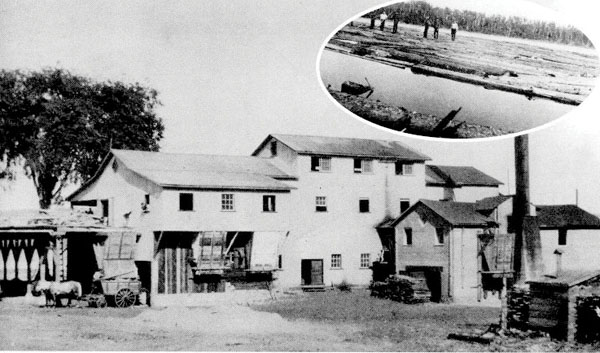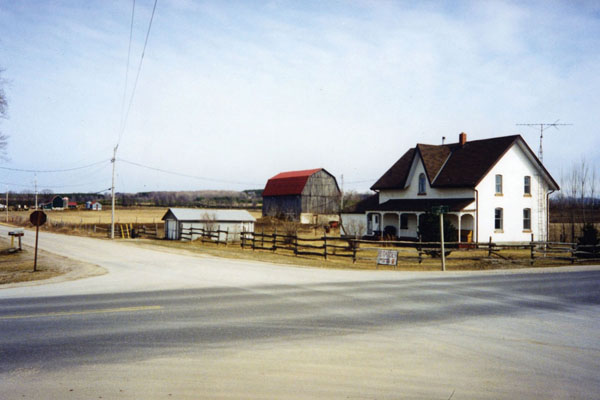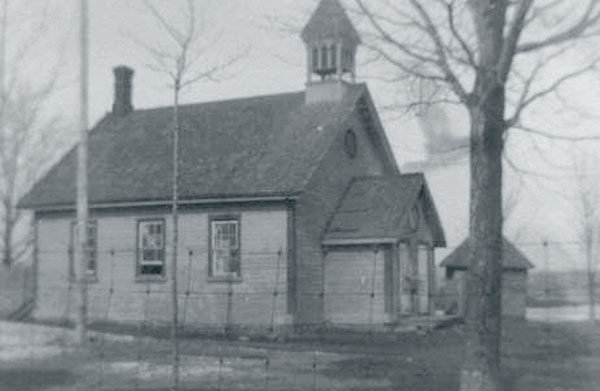
Thunder Bay Beach Mill (1910). Private Collection J. Barry
Ghost Towns of Tiny Township
By Bonnie Reynolds
Tiny Township may not have hot desert winds blowing tumbleweeds down its concession roads, nor bleached steer skulls lying beside its roads. It has no abandoned taverns/inns echoing with long ago laughter of card games and country-dances - but it does have ghost towns. Perhaps we should call them ghost hamlets, though.
What is a ghost town? Basically it is a "ghost" of what once was. It may have no surviving buildings or it may retain a handful of residences. Tiny Township of old had a number of small communities, some of which survived and some didn't.
As the area’s forests were cleared, hamlets sprang up around road intersections. The trees that the lumber companies harvested were at first floated downstream to sawmills at the mouths of the rivers and creeks flowing into Georgian Bay. Hamlets grew up around these sites and you have only to look at photographs of the mills of Thunder Bay Beach, Wyebridge and Stoney Point (near Woodland Beach) to understand the importance of the industry. Once the timber limits were depleted, most of these mill sites faded away, as they lost their reason for being.

Thunder Bay Beach Mill (1910). Private Collection J. Barry
The crossroad hamlets typically consisted of a general store/post office, blacksmith shop, school, church, and a few houses. These communities lasted a little longer, but with the introduction of rural mail delivery and the temperance movement, they too began to fade away. Prior to home delivery, residents of rural areas had to make a trip to the nearest post office to pick up their mail. For many, collecting their mail would be a part of the routine of going to the general store and perhaps selling produce to village residents. It was a good opportunity to catch up on the local gossip. Afterward the men might stop off for a pint or two at the village hotel.
It is interesting to note that at one time Tiny Township could boast of having at least twenty-four post offices. Older residents may recall collecting their mail in Gibson, Randolph, Laurin and Lefaive's Corners. A number of "summer operation only" post offices were located along our shoreline communities. Postcard collectors prize the local cards and postmarks associated with these offices.
Today we often drive past a scattering of houses or perhaps the ruins of a building, never realizing that these are the ghosts of a once vigorous community. Very little has been written or recorded about these hamlets. Hopefully this article will spur those with memories to record them before they are lost.

Present Day Randolph
Gibson
The small hamlet of Gibson was located in the southwest corner of Tiny Township and had its center at the intersection of Concession 3 and County Road 29. When the early settlers arrived they found the area covered by a dense cedar bush. Early pioneer, William Spring, remembered the trees being cut into four foot lengths and hauled to nearby Stoney Point, where they were loaded onto barges and taken to Chicago to be used to make corduroy roads. The logs were eventually covered with asphalt. Interestingly, when the roads were being repaired, some logs were exposed that bore the stamp or mark of the Chicago Lumber Company (based in Penetanguishene) that shipped logs from the Gibson area.
A steam sawmill, owned by the Dean brothers, produced lumber which was used to build many of the barns and homes around Gibson. Gibson also boasted a church - known as Bayview Presbyterian (Lot 23, Con3) -- a school, and a small general store/post office.
Today, only a couple of houses and the converted school house survive. The church was torn down and the brick used to build a home in nearby Saurin. The bricks may have been returning home, as a Thomas McGrath operated a brickyard in Saurin, which was reputed to have supplied brick for many of the larger homes, schools and churches in the surrounding area. Saurin is located just over the townline in Flos, now Springwater, Township.

Randolph School
Randolph
The hamlet of Randolph was located at the intersection of Concession 15 and the Thunder Bay Beach Road. Originally called King's Mills, after the owners of a local sawmill, it became known as Randolph in 1885. It had a general store, post office, school, sawmill, and Anglican Church. Today there are only a few homes, one being the converted schoolhouse, and a large cross. Some of the early families were the Brissettes, the Vents, the Lambs, the Downers, the Kings and the Randolphs. The Randolph hill commands a magnificent view of Nottawasaga Bay and Collingwood to the west, Midland and Port McNicoll to the southeast and Penetanguishene to the east.
Vint's Settlement
The area in Tiny Township around Concessions 11 to 14. It was settled by various branches of the Vint family and the Rowats, Campbells, Griers and McConnells.
Lefaive's Corners
Located at the intersection of Concession 12 and County Road 6. The renovated school (now a home) and a couple of homes are all that remain of the original settlement. A post office was located here and nomination meetings for township council once took place in the school.
Laurin
Located on Concession Road 18, northwest of Lafontaine. A school and post office operated here. The school closed in 1964 and the building burned down in 1970.
As you pass through these ghost communities, reader, exercise your imagination, and envision them as vital centres for our early pioneer families.
The Township could assist such glances back in time by erecting small signs where these communities once stood. Early topographic maps, like the one included with this article, give the locations of early settlements.